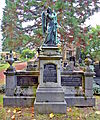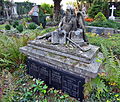Old Saarlouis cemetery
The Old Saarlouis Cemetery is located south of Walter-Bloch-Straße (formerly Von-Lettow-Vorbeck -Straße ) and was laid out in 1773. It is approx. 300 m long and has an area of 1.7 hectares. The cemetery , which is now a listed building , has been expanded several times and is still in use today. There are over 600 graves there, 131 of them on the Jewish part, where the last burial took place in 1997.
history
Parish cemeteries
After the city of Saarlouis was founded, the interior of the Saarlouis Church of St. Ludwig and St. Peter and Paul also served as a burial place for the citizens of the fortress town on the Saar. A first cemetery was established on July 17, 1685 by Father Gargan in the outer works of the bridgehead in front of the German Gate. Later this cemetery was only used as a burial place for members of the military. So in 1691 they wanted to build a new cemetery around the church, but soon abandoned this project for reasons of space. A cemetery was also laid out for monks and citizens behind the Augustinian monastery built between 1693 and 1696 (today the site of the Saarlouis Canisianum ). Here, as a citizen, you had to pay for graves. For all other citizens there was a cemetery with a chapel and a house of the dead on the site of the former riding arena (barracks 2 and 4) since 1714 . For reasons of hygiene, this cemetery was abandoned in 1773 by ordinance of the city authorities and the current "Old Cemetery" (new occupancy ended in 1997) was laid out in front of the French Gate. On the instructions of Trier Auxiliary Bishop Johann Nikolaus von Hontheim , all donations made for the former cemetery chapel were transferred to the main altar of the Ludwigskirche.
City residents of the Protestant denomination who moved to the Kingdom of Prussia when the fortress became part of the Prussian kingdom were initially buried in the garrison cemetery. This cemetery was also dedicated for the burial of Catholic military personnel. In 1850 there was a dispute between the city and the parish over the ownership of the cemetery. An agreement could not be reached. Thanks to a donation from Prelate de Bervanger and his brother in 1837 in the amount of 321 thalers, a morgue was built in the cemetery, which was to remain the property of the church. People of different faiths could also be laid out here. The hall also served as an apartment for the gravedigger and his family.
The "New Cemetery" at Soutyhof was inaugurated on May 29, 1921.
In the course of the history of today's "Old Cemetery", several parts were created. The earliest "historical part" was expanded in the 19th century by the "general part", followed by the "garrison cemetery". The garrison cemetery commemorates those who died in the Franco-Prussian War and the two world wars. When the graves were erected, no distinction was made according to nationality or rank. German, Russian, Italian and French soldiers lie next to each other. In addition to team ranks, Generals Edmund Wild and Karl Ferdinand von Langen are also buried. A memorial was erected to commemorate the 87 victims of the Choisy Redoubt explosion . In the accident of September 14, 1916, an ammunition dump in the train barracks exploded, leaving 96 dead and more than 100 injured. In 1905 the extension to the south by the "Israelite Cemetery" with 131 graves took place. Until then, the Saarlouis Jews were buried in the Dieffler cemetery . In the back, some stones placed in a circle remind of the synagogue. The "Association for the Preservation of Monuments at the Old Cemetery Saarlouis eV" advocates the preservation of the cemetery. The cemetery is not to be confused with the in Saarlouis district Fraulautern that are available old cemetery .
Well-known personalities buried
- Michel Reneauld (1760–1826), division general under Napoleon, Lord Mayor
- Karl Marx (journalist) (1897–1966), founder of the general Jewish weekly newspaper
- Richard Nospers (1948–2009), Lord Mayor of Saarlouis
- Ottmar Schreiner (1946–2013), German politician
supporting documents
-
↑ The artist of the 117 cm high bronze angel is not known. Production took place around 1900 by the company WMF-Geislingen / Steige (internal WMF catalog number 722). In 2016, the Friends of the Alter Friedhof had the angel completely reworked by Haber and Brandner, Regensburg, because the internal framework with plaster of paris and iron reinforcement was irreparable. The metal jacket made of copper core electroplating was cleaned, supplemented and re-soldered.
About the restoration of a WMF catalog figure, compare: A. Doktor, B. Meißner, M. Mach: Galvanoplastiken - chemical analysis and restoration. In bronze and electroplating. Workbook 5. State Office for Monument Preservation Saxony and Saxony-Anhalt. P. 138ff. - ↑ www.alemannia-judaica.de
- ↑ Georg Baltzer: Historical Notes on the City of Saarlouis and its Immediate Surroundings , Part One: Historical Notes on the City of Saarlouis, Part Two: Historical Notes on the Immediate Surroundings of Saarlouis, reprint of the 1865 edition, Dillingen / Saar 1979, Part 1 , P. 113.
- ↑ Gernot Karge and Hans Jörg Schu: The Old Cemetery Saarlouis - Its meaning, its history, its tombs , Saarlouis 2008.
- ↑ Georg Baltzer: Historical Notes on the City of Saarlouis and its Immediate Surroundings , Part One: Historical Notes on the City of Saarlouis, Part Two: Historical Notes on the Immediate Surroundings of Saarlouis, reprint of the 1865 edition, Dillingen / Saar 1979, Part 1 , P. 113; Severin Delges: History of the Catholic parish St. Ludwig in Saarlouis . Saarlouis-Lisdorf 1931, extension by Heinrich Unkel in 1952, extension by a third part by Marga Blasius in 1985, part 1, pp. 18-19, pp. 92-93.
- ↑ Catholic Parish Office St. Ludwig in Saarlouis (ed.): St. Ludwig - Saarlouis , Erolzheim 1960, pp. 6-7.
- ↑ www.saarlouis.de
Web links
Coordinates: 49 ° 18 ′ 35.4 " N , 6 ° 45 ′ 25.4" E





